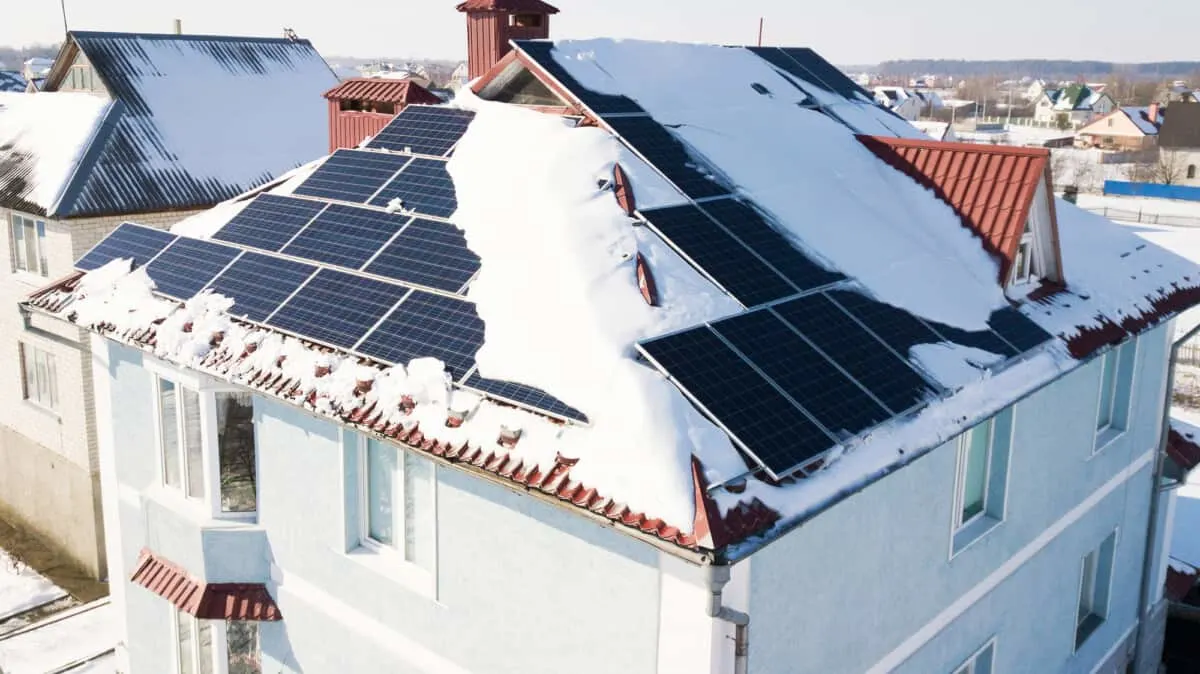Snow building up on your solar panels can reduce the amount of energy you are able to produce. If the snow doesn’t melt on its own, your power supply can be greatly diminished. However, it is often best that you do not attempt to remove the snow from your solar panels yourself because you risk injuring yourself or damaging the panels.
So what do you do?
Solar panels are designed to attract heat. Thankfully, this feature combined with the way they are pitched to a surface (either on the ground or on the roof), as well as the slippery glass surface, ensures that snow does not stick around for long.
Once a portion of the solar panel is exposed to the sun, it will speed up the rate at which the rest of the snow will melt off.
This is a similar phenomenon as with removing snow and ice from a windshield. Once you get it started, it speeds up the process naturally.

Can Snow Damage Solar Panels?
Many modern solar panels have a support structure with localized stress management points that provide support for the panels when dealing with the weight of snow. If you are in an area that often sees a large amount of snowfall in the winter, this is likely something that was considered during the decisions of the locations and pitch of the solar panels.
In fact, snow can sometimes be a benefit to solar panels as it helps to clean and remove any small debris (like the windscreen of a car) which could help to further improve your electricity generation once melted.
If at any point you are concerned that snow could be damaging your solar panels, it is best to contact the installation team, solar panel manufacturer, or consult with another solar panel company who may be able to provide you with information or solutions.
Related Posts:
- How to Remove Snow from a Gazebo
- Removing Snow from a Satellite Dish Safely
- Best Ways to Remove Snow from a Gravel Driveway
Can Solar Panels Produce Electricity When Covered In Snow?
When a solar panel is covered in snow, it is unable to produce electricity. However, just because you see a large amount of snowfall each year does not mean you should rule out buying solar panels as a long-term investment for saving on your electric bill.
Many of us only see snow for three months of the year. This leaves 3/4 of the year (nine months) of reasonable solar panel performance.
I found this calculator to be really useful in understanding the average sunlight for our region on an annual basis and therefore the amount of money we may save by having solar panels installed.
How To Remove Snow from Solar Panels Safely
Having your solar panels covered in snow and unable to generate electricity can be frustrating. However, most solar panel manufacturers and installation advisors recommend that you allow the snow to melt naturally from your panels and do not attempt to remove it yourself.
Solar panel systems on roofs can be both difficult and dangerous to access. While removing snow from a roof can often be easy, removing snow from solar panels requires you to be careful and delicate in order to not injure yourself or damage the panels.
Thankfully, snow panels tend to shed snow naturally very well as they are designed to absorb the sun’s heat and are placed in a direction to do so.
Solar Panel Roof Rakes are designed with soft foam to help you remove snow from on top of your solar panels. These are telescoping poles with a long reach that you can drag across the panels to remove the snow buildup.
While roof rakes can definitely help, you do need to use them carefully. Otherwise, you could damage the panels.
Ultimately the damage you could cause from attempting to remove the snow (to the panels or yourself) from the panels yourself is likely to far outweigh the money lost from the panels not producing energy for a couple of days.
Related Posts:
- Ways to Remove Snow Without a Shovel
- How to Prevent Snow from Building Up in a Truck
- Removing Snow from Your Balcony or Composite Decking Without Damage
- How to Use a Salt Spreader to Prevent Snow and Ice Buildup
How To Prevent Snow from Building Up on Solar Panels Again in The Future
Currently there are no tried-and-true methods for preventing snow from building on snow panels.
There are a variety of ways that are suggested by others for removing the snow, but those methods can potentially damage the panels or void the warranty. These methods include:
- Using rock salt. Salt is corrosive and can cause damage and staining. (See our guide on everything you need to know about using rock salt for snow.)
- Spraying solar panels with a hose. This just replaces the snow with water, which can then freeze and become ice.
- Using a de-icer liquid. Spraying a chemical liquid on your solar panels might void your warranty or cause other issues.
- Coating panels with RainX or car wax. While you might think that this method will have the snow slide right off, it can also void your warranty and cause build-up on the panels.
- Roof Rakes. While these long, telescoping rakes can easily drag snow off of the panels, they could also cause damage, too. There are solar panel snow rakes that you can use with caution.
Honestly, as snow causes little to no damage to solar panels and often does not stick around for long, it is not something I would consider worrying a lot about. If you are worried about your solar panels’ ability to cope with large amounts of snow, then it is best to contact the manufacturer who may be able to advise you on strategies that are specifically suited to your make, model, and fitting.

